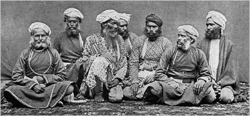Thuggery

Group of Thugs around 1894
|
|
| Founded | Before 1356 |
|---|---|
| Named after | Hindi word for deceit |
| Founding location | Central India |
| Years active | At least 450 years |
| Territory | Indian subcontinent |
| Criminal activities | Murder, robbery |
Thuggee or tuggee (Hindi: Nepali ठग्गी ṭhaggī; Urdu: ٹھگ; Sanskrit: sthaga; Marathi: ठक; Sindhi: ٺوڳي، ٺڳ; Kannada: ಠಕ್ಕ thakka) refers to the acts of Thugs, an organised gang of professional robbers and murderers. Thugs travelled in groups across the Indian sub-continent for six hundred years. Although the Thugs traced their origin to seven Muslim tribes, Hindus appear to have been associated with them at an early period. They were first mentioned in Ẓiyā-ud-Dīn Baranī's History of Fīrūz Shāh, dated around 1356. During the 1830s, the Thugs were targeted for eradication by Governor-General of India, William Bentinck and his chief captain, William Henry Sleeman. Thugs were apparently destroyed by this effort. To take advantage of their victims, the Thugs would join travellers and gain their confidence; this would allow them to surprise and strangle the travellers with a handkerchief or noose. They would then rob and bury their victims. This led to the Thugs being called Phansigar (English: "using a noose"), a term more commonly used in southern India.
The English language's thug traces its roots to this, from the Hindi ठग (ṭhag), which means "swindler" or "deceiver". Related words are the verb thugna ("to deceive"), from the Sanskrit स्थग (sthaga ", , fraudulent") and स्थगति (sthagati, "he conceals"). This term, describing the murder and robbery of travellers, is popular in South Asia and particularly India.
...
Wikipedia
